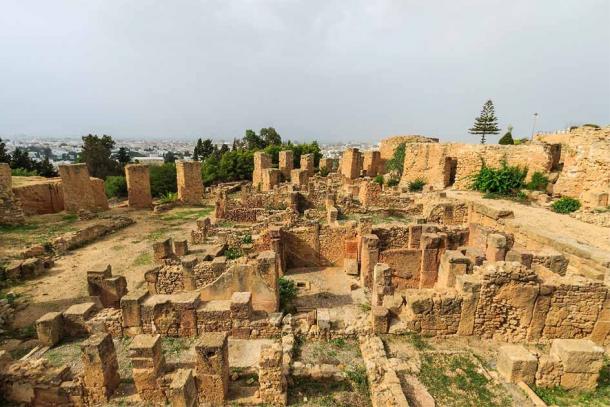
Salt Sowing: An Ancient Method to Settle Scores
Many people use salt to bring out the flavor in their food. Others spread it on icy roads and sidewalks to give vehicles or pedestrians some grip as they go about their day. It is, by most accounts, a completely mundane component of day-to-day life. But it wasn’t always so. In ancient times, salt occupied a much higher place in the collective consciousness of numerous societies. It could be a symbol of preservation and purity or of utter destruction, a curse upon the land. How much truth is there to stories that ancient civilizations sowed enemy lands with salt to ensure their complete and utter ruin?
Salt as Symbol in Scripture
Theologians are still debating the meaning of salt in its biblical context. In some passages, salt is seen as a symbol of a covenant or binding agreement. Several cultures practiced the sharing of salt after concluding such agreements, and the Bible contains numerous references to the importance of offering salt at the table. Throughout history, salt was a critically important commodity often used to preserve food for storage and long journeys; thus, in this context, salt is a symbol of preserving an agreement or fellowship.
There are, however, numerous occasions in the Bible where salt takes on a much more sinister meaning. While salt could be symbolic of one’s covenant with God, it could also be used as punishment when that relationship was betrayed. The cities of Sodom and Gomorrah were razed to the ground after they incurred God’s wrath, with only a man named Lot and his family spared. They were commanded to leave and never look back, but Lot’s wife disobeyed and was turned into a pillar of salt for disobeying God’s command.
- ‘Fire and Brimstone’ that Destroyed Biblical Sodom Matches Findings of Cosmic Catastrophe 3,700 Years Ago
- Salt: Treasure of the Ancient World and Highly-Valued Currency of the Roman Empire

Oil painting "The Destruction of Sodom and Gomorrah" by François de Nomé, circa 1593 (mark6mauno / CC BY 2.0)
In other examples, barren wastelands are described in terms of being salty. Land sowed with salt, then, was a symbol of desolation. Such a concept is revealed in the Book of Judges, in which Abimelech, king of Shechem, destroyed the city of Shechem and sowed the land with salt afterward to ensure its complete devastation. This same idea was, supposedly, employed by the Romans during the destruction of Carthage.
- Once an Ancient Mine, The Breathtaking Underground Salt Cathedral of Colombia
- Unidentified Salt God Emerges from Ancient Bulgarian Cult Site

Tell Balata, archaeological site of the destroyed city of Shechem, near present-day Nablus, Palestine (Dr. Avishai Teicher / CC BY SA 4.0)
Salting the Earth in Carthage? A Tale to be taken with a Pinch of Salt
There is a misconception that Roman legions sacked Carthage, ploughed it to the ground, and then sowed the land with salt to ensure the city could never rise again. In fact, this seems to be an invention of a much later era. While many ancient Roman historians wrote of the ruin of Carthage, none ever mentioned ploughing the land or salting it. The first recorded references to these exaggerations appeared in the 20th century, repeated by a series of historians, without any of them ever questioning the source.
While it does not appear that the Romans ever salted the lands of Carthage, there are numerous primary sources from other cultures that suggest the practice was relatively common. Jewish, Hittite, and Assyrian texts spanning more than 1000 years contain references to leaders and armies who sowed the lands of their enemies with salt. Hattusa, Taidu, and Hunusa are just a few examples of cities that faced such devastation in defeat. The act was seen as symbolic, a curse of sorts, intended to ensure that nobody would be able to return to the land ever again.

Although Romans may not have sown salt on the remains of Carthage, the ruins still standing today attest to the city’s utter devastation. (Evgenii Emelianov / Adobe Stock)
It is likely that more modern scholarship latched onto the Book of Judges, and the examples seen in the ancient texts referenced above, and simply added the ploughing and salting of Carthage to the history. Primary sources regarding Carthage discussed Rome’s desire that the city would never rise again, so perhaps scholars simply made a connection that was never there. After all, armies had certainly salted the lands of their enemies in the past. Long after the fall of Rome, there are other, more contemporary examples of sowing salt as an act of revenge.
Sowing Salt as a Punishment for Portuguese Traitors
There is at least one primary source that confirms the use of salt against an enemy, one that dates only to the 18th century. In Portugal, the 8th Duke of Aveiro is said to have conspired with other nobles to murder King Joseph I of Portugal and ascend to the throne, in a scandal later known as the Távora affair. Through a letter written by an Englishman named Joseph Hughes, who was living in Lisbon at the time, we learned that several conspirators attacked the king on a road late one night and severely wounded him. They were ultimately discovered, brutally tortured, executed, and confession extracted. As a result, the conspirators and all Távora men were executed (the women and children spared due to Queen Mariana’s intervention). Their houses were torn down, and the land salted. In place of their formerly opulent palace in Lisbon, a stone memorial still stands today. The translated Portuguese text reads:
"In this place were put to the ground and salted the houses of José Mascarenhas, stripped of the honors of Duque de Aveiro and others, convicted by sentence proclaimed in the Supreme Court of Inconfidences on the 12th of January 1759. Put to Justice as one of the leaders of the most barbarous and execrable upheaval that, on the night of the 3rd of September 1758, was committed against the most royal and sacred person of the Lord Joseph I. In this infamous land nothing may be built for all time."

The Beco do Chão Salgado ("alley of the salted ground") was once the site of the Duke of Aveiro’s palace. After an assassination attempt on the king, the Aveiro lands were salted, and a stone monument marks the former palace, now essentially a public urinal. (RicardoFelipePereira / CC BY SA 4.0)
Conclusion
Salt still holds a prominent place in modern society. It is ubiquitous, although now for very mundane, innocent reasons. It is fascinating to look over the history of this seemingly innocuous commodity and find that its purpose and symbology has shifted constantly on a global scale. Over millennia of human history salt, has been a component of ritual, a preservative of foods and covenants, a common table condiment, and more. It can be spread on chicken or pasta, rubbed in a wound, a symbol of a very decent sort of person or, as we’ve seen, sown into the lands of your worst enemy to banish their memory forever.
Top image: Hands sprinkling salt. Humans have cultivated salt for centuries, but in some places, salt has covered the earth. Source: Left zlikovec / Adobe Stock
By Mark Johnston
References
Fensham, C.F. May, 1962. Salt as Curse in the Old Testament and the Ancient Near East. The Biblical Archaeologist, Vol. 25, no. 2.
Garlington, D. December, 2011. “ The Salt of the Earth” in Covenantal Perspective. Journal of the Evangelical Theological Society, vol. 54, no. 4.
Hughes, J. 1759. An authentick letter from Mr. Hughes, a Gentleman residing at Lisbon, to his Friends in London. Available at: https://books.google.ca/books?id=hmNZAAAAcAAJ&q=salt&redir_esc=y#v=snippet&q=salt&f=false.
Ridley, R.T. April 1986. To be Taken with a Pinch of Salt: The Destruction of Carthage. Classical Philogy, vol. 81, no. 2.
Salting the Earth. n.d. Military History Fandom. Available at: https://military-history.fandom.com/wiki/Salting_the_earth.















